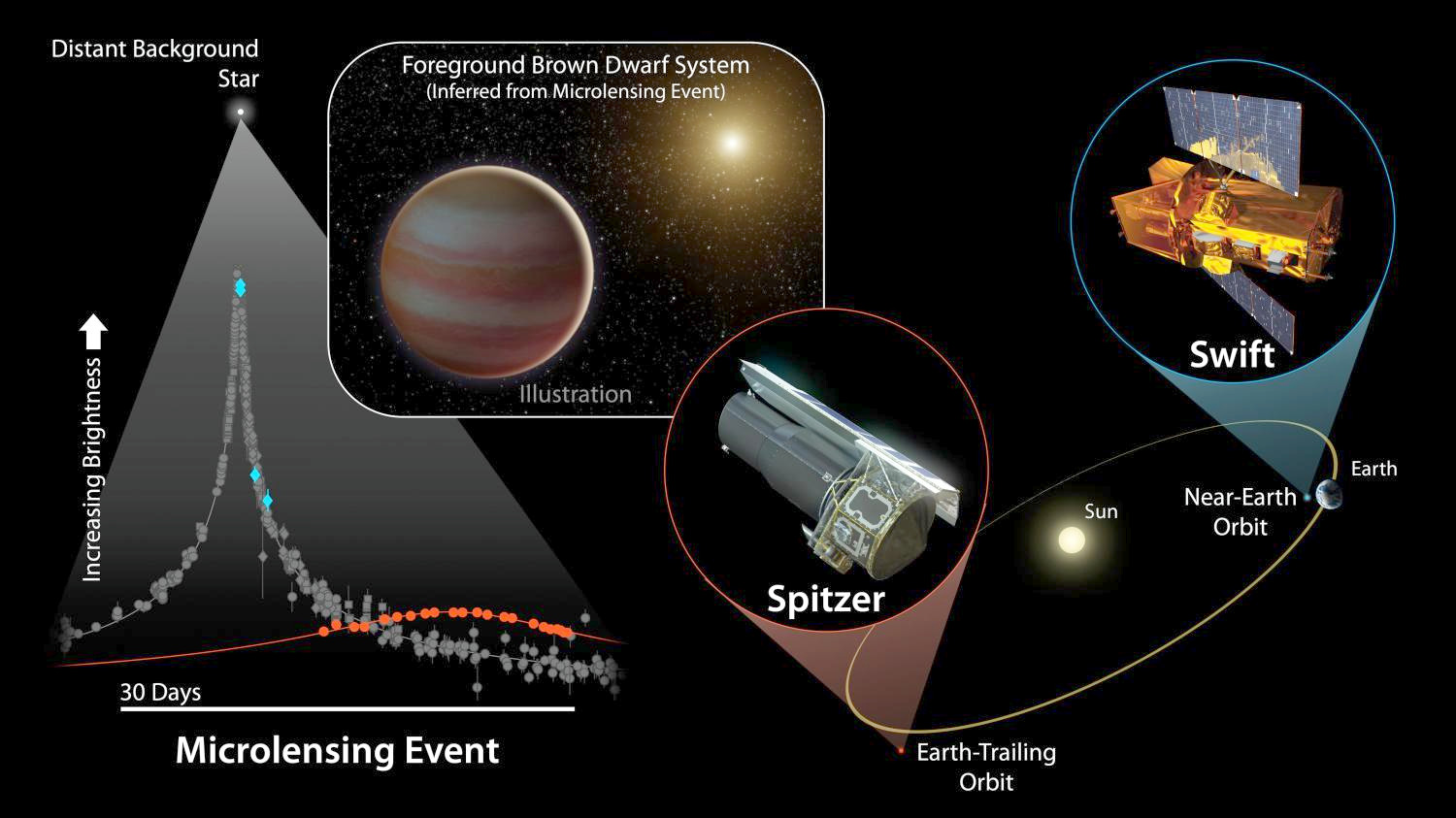
Brown dwarfs are thought to be the missing link between planets and stars, with masses up to 80 times that of Jupiter. But their centres are not hot or dense enough to generate energy through nuclear fusion the way stars do. Curiously, scientists have found that, for stars roughly the mass of our Sun, less than 1 percent have a brown dwarf orbiting within 3 AU (1 AU is the distance between Earth and the Sun). This phenomenon is called the “brown dwarf desert.”
The newly discovered brown dwarf, which orbits a host star, may inhabit this desert. Spitzer and Swift observed the microlensing event after being tipped off by ground-based microlensing surveys, including the Optical Gravitational Lensing Experiment (OGLE). The discovery of this brown dwarf, with the unwieldy name OGLE-2015-BLG-1319, marks the first time two space telescopes have collaborated to observe a microlensing event.
“We want to understand how brown dwarfs form around stars, and why there is a gap in where they are found relative to their host stars,” said Yossi Shvartzvald, a NASA postdoctoral fellow based at NASA’s Jet Propulsion Laboratory, Pasadena, California, and lead author of a study published in the Astrophysical Journal. “It’s possible that the ‘desert’ is not as dry as we think.”
What is microlensing?
In a microlensing event, a background source star serves as a flashlight for the observer. When a massive object passes in front of the background star along the line of sight, the background star brightens because the foreground object deflects and focuses the light from the background source star. Depending on the mass and alignment of the intervening object, the background star can briefly appear thousands of times brighter.
One way to understand better the properties of the lensing system is to observe the microlensing event from more than one vantage point. By having multiple telescopes record the brightening of the background star, scientists can take advantage of “parallax,” the apparent difference in position of an object as seen from two points in space. When you hold your thumb in front of your nose and close your left eye, then open it and close your right eye, your thumb seems to move in space — but it stays put with two eyes open. In the context of microlensing, observing the same event from two or more widely separated locations will result in different magnification patterns.
The new study
Spitzer observed the binary system containing the brown dwarf in July 2015, during the last two weeks of the space telescope’s microlensing campaign for that year.
While Spitzer is over 1 AU away from Earth in an Earth-trailing orbit around the Sun, Swift is in a low Earth orbit encircling our planet. Swift also saw the binary system in late June 2015 through microlensing, representing the first time this telescope had observed a microlensing event. But Swift is not far enough away from ground-based telescopes to get a significantly different view of this particular event, so no parallax was measured between the two. This gives scientists insights into the limits of the telescope’s capabilities for certain types of objects and distances.
“Our simulations suggest that Swift could measure this parallax for nearby, less massive objects, including ‘free-floating planets,’ which do not orbit stars,” Shvartzvald said.
By combining data from these space-based and ground-based telescopes, researchers determined that the newly discovered brown dwarf is between 30 and 65 Jupiter masses. They also found that the brown dwarf orbits a K dwarf, a type of star that tends to have about half the mass of the Sun. Researchers found two possible distances between the brown dwarf and its host star, based on available data: 0.25 AU and 45 AU. The 0.25 AU distance would put this system in the brown dwarf desert.
“In the future, we hope to have more observations of microlensing events from multiple viewing perspectives, allowing us to probe further the characteristics of brown dwarfs and planetary systems,” said Geoffrey Bryden, JPL scientist and co-author of the study.



